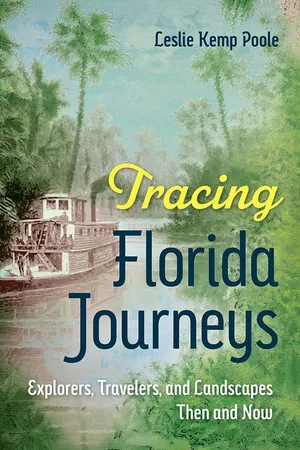
Tracing Florida Journeys
Explorers, Travelers, and Landscapes Then and Now
- English
- ePUB (mobile friendly)
- Available on iOS & Android
About this book
Florida Historical Society Charlton Tebeau Award
Florida Book Awards, Bronze Medal for Florida Nonfiction
Discover Florida’s unique places across time through writings from history
How has Florida’s land changed across five centuries? What has stayed the same, and what remains only in memory? In Tracing Florida Journeys, Leslie Poole delves into the stories of well-known explorers and travelers who came to the peninsula and wrote about their experiences, looking at their words and the paths they took from the perspective of today.
In these pages, John Muir and Harriet Beecher Stowe write about their visits to Florida, reflecting their expectations of a place that was touted to be “paradise.” John James Audubon finds riches of bird life in the Keys. Zora Neale Hurston travels to turpentine camps and sawmills documenting the stories and music of workers and residents. Jonathan Dickinson and Stephen Crane recount shipwrecks along a sparsely populated coastline. Members of Hernando de Soto’s violent 1539 expedition of conquest describe their struggles with dense swamps, forests, and rivers, and resistance from the Native people they exploited.
Using journals and articles by these and other authors that date back to the early European exploration of the region, Poole retraces their steps. The land they write about is often hard to imagine in today’s Florida, a top destination for tourists filled with almost 22 million residents. These stories show the evolving history of the state and the richness of its natural resources. Poole’s comparisons also point to the people who have been displaced and the ecosystems that have been dramatically altered by exploration and development.
Highlighting the Florida that was and the Florida that exists now, Poole brings together historical research, interviews with experts, and her personal experiences to tell a revealing story of the state’s natural history.
Funding for this publication was provided through a grant from Florida Humanities with funds from the National Endowment for the Humanities. Any views, findings, conclusions or recommendations expressed in this publication do not necessarily represent those of Florida Humanities or the National Endowment for the Humanities.
Frequently asked questions
- Essential is ideal for learners and professionals who enjoy exploring a wide range of subjects. Access the Essential Library with 800,000+ trusted titles and best-sellers across business, personal growth, and the humanities. Includes unlimited reading time and Standard Read Aloud voice.
- Complete: Perfect for advanced learners and researchers needing full, unrestricted access. Unlock 1.4M+ books across hundreds of subjects, including academic and specialized titles. The Complete Plan also includes advanced features like Premium Read Aloud and Research Assistant.
Please note we cannot support devices running on iOS 13 and Android 7 or earlier. Learn more about using the app.
Information
Table of contents
- Cover
- Title Page
- Copyright Page
- Dedication
- Epigraph
- Contents
- Introduction: Travelers in Time and Place
- 1. Hernando de Soto: Travels and Travails in Search of Treasure, 1539–1540
- 2. Jonathan Dickinson: A Shipwreck Survivor’s Story, 1696
- 3. William Bartram: Botanizing in Paradise, 1774
- 4. John James Audubon: Looking for a Paradise of Birds, 1831–1832
- 5. John Muir: Finding Florida Beauty on Foot, 1867
- 6. Harriet Beecher Stowe: A Voyage into “Fairy-Land,” 1873
- 7. Middle/West Florida Travelers: Hopes in the Panhandle, 1765–1891
- 8. Ingraham Everglades Expedition: The Myth and Allure of “Conquering” the Everglades, 1892
- 9. Stephen Crane: A Journalist’s Adventure, 1897
- 10. Zora Neale Hurston: Collecting and Celebrating Florida Stories, 1927–1939
- 11. Marjorie Kinnan Rawlings: Harmony in Rural Florida, 1931
- Final Thoughts
- Acknowledgments
- Notes
- Index
- About the Author